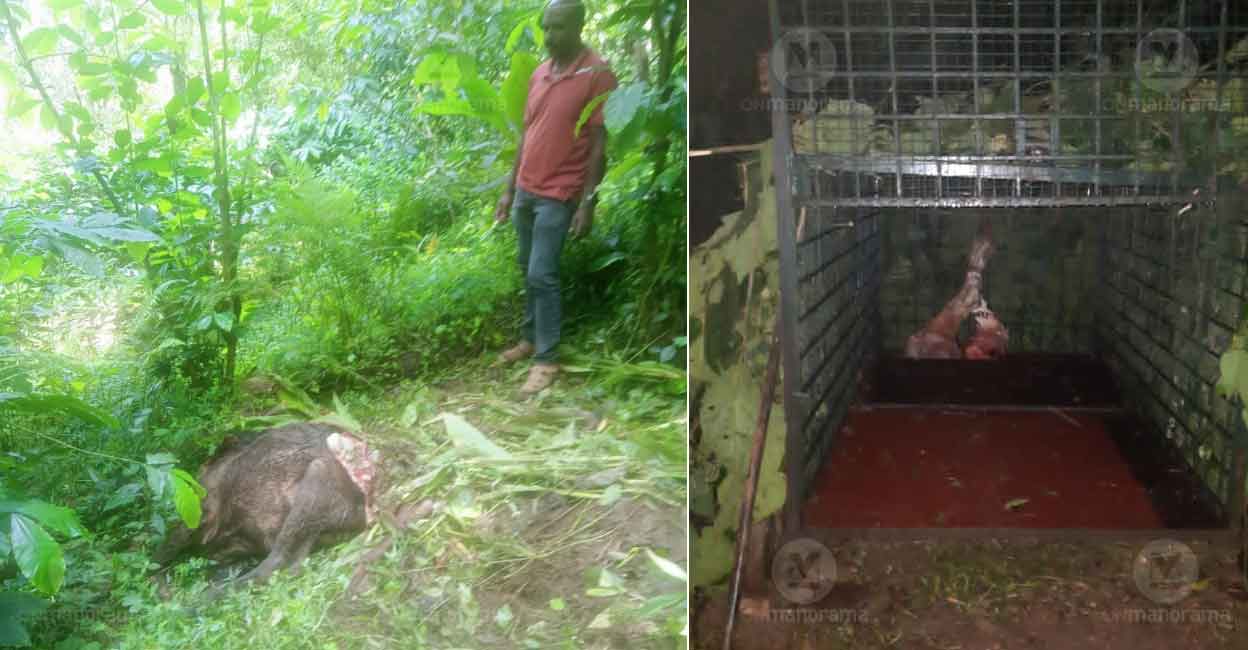Two tigers wreak havoc in Wayanad, 10 domestic animals killed in 17 days

Mail This Article
Kasaragod: Cheeral village in Wayanad was seething on Tuesday. The residents shut down their businesses, farmers secured their cattle, children boycotted their classes, homemakers locked their houses and all of them hit the streets protesting against the government for not catching a tiger wreaking havoc in their village in Nenmeni grama panchayat.
In the past 17 days starting September 25, the tiger -- identified as a 10-year-old male and possibly with a missing canine tooth -- killed six cows and seriously injured another one. The ageing tiger's last kill was on October 9. The prey was a four-year-old Holstein Friesian (HF) that gave 25 litres of milk every day and was valued at Rs 1.25 lakh. Its owner Ramachandran (65) of Mulavankolli depended on the cow to run his house and take care of his ailing wife.
That attack was the breaking point for the Cheeral residents living on the edge. Around 1,500 people under the banner of an all-party committee marched through the deserted streets of Cheeral for 3km and held a protest in front of the Thottamoola Forest Station at Pazhoor. It was a 'people's hartal'.
M A Suresh, the convenor of the committee, alleged the officials of the Forest Department often dispersed the protesters with empty assurances. "Today, the collector sent the tahsildar for talks instead of the sub-collector. That shows how seriously the government is taking the issue," he said.
CPM leader and former MLA of Kalpetta C K Saseendran asked the Forest officials to act fast. "These barricades are not a deterrent. The people will cross them. Don't push the people to do that," he said at the protest site.
District panchayat president Samshad Marakkar of the Congress said the government should not see the peaceful protest as people's powerlessness. "Our demands are just. We are asking the government to protect our right to life," he said.

Even as the government was trying to get its head around the attacks in Cheeral village, another tiger killed three goats of autorickshaw driver C Assainar at Meenangadi grama panchayat, between Kalpetta and Sulthan Bathery and 20km from Cheeral.
"It was raining heavily in the early hours of Sunday and so we could not hear the cries of our goats," said Assainar of Krishnagiri.
There were five goats in the elevated shed, four of them were tethered and always left free. The tiger killed a four-year-billy and a three-year-old nanny. "But it could not take out the goats because they were tied down. But in the commotion, the goat which was not tied must have got out of the shed and got picked up by the tiger" said Assainar.
The half-eaten bloodied carcass was found 100m away from his house at Krishnagiri.
The tiger attacks have changed the lifestyle of the people. "Before shops in Krishnagiri used to be open till 8.30 pm and we used to ply our autorickshaw till 9 pm. Now we are all inside our house by 6-6.30 pm," said Assainar.

Meenangadi panchayat president K E Vinay of the Congress said tigers had attacked domestic animals in Mylambadi, CC, and Avayal (wards no. 3, 4, and 5) in the past couple of months. "This is the first time, a tiger has attacked in ward 7 (Rattakundu)," he said.
To be sure, the tiger prowling in Meenangadi panchayat has not been identified, yet. After Krishnagiri, it killed a wild boar in Kumbaleri in the same panchayat.
Vinay said the Forest Department had assured him that it would catch the tiger. "We want to believe them," he said.
Around 7 pm on Wednesday, a tiger was caught on a CCTV entering the compound of a house at Dhottappankulam in Sulthan Bathery municipality. "It crossed the road, and jumped into a private compound and disappeared. No attacks were reported. It could be a floater," said an official. (see below video).
'Forest Department wasted two chances to catch the tiger'
But the residents of Cheeral had almost lost trust in the Forest Department after it "wasted" two opportunities to cage the tiger, identified as W-43.
The tiger first killed a two-year-old HF that was three months pregnant at Karuvally on September 25. It belonged to Ramdasan.

After seven days, around 4.30 am on October 2, it killed a six-month-old calf at Shanoj Daniel's house at Mundakolly. It left the carcass 50m away from the cow shed after eating one leg. "We informed the Forest officials. They came and installed cameras to capture the tiger's image instead of setting up a trap cage," said Shanoj (40).
The tiger returned the same night, dragged the carcass 50m further down, and dined on it. On October 4, it came again and finished off the rest of the calf. It was also captured on the camera.
Wayanad Wildlife Sanctuary warden Abdul Aziz said the permission to set up trap cages is given by the principal chief conservator of forests (Wildlife) & chief wildlife warden (Ganga Singh) based on the recommendations of a committee. The committee has a representative of the chief wildlife warden, a representative of the National Tiger Conservation Authority (NTCA), divisional forest officers from neighbouring areas, panchayat member concerned, and veterinary doctors. For the committee to make an informed recommendation, it would need evidence, and that was why the camera traps were placed on Shanoj's property. "Apart from the chief wildlife warden's permission, we also need NTCA's approval to set up cages," Aziz said. The department needs separate permission to fire tranquilliser darts.
During this time, the tiger went on a killing spree. Its pugmarks were found from Mookoothikunnu to Cheeral, a 6km range.
Around 10.45 pm on October 6, the tiger sneaked into the cow shed of Ayyappan at Mundakkolli. Hearing a commotion in the shed, he ran out and saw his cow bleeding. (It later died on October 9.)
Ayyappan alerted the rest of the farmers in the locality.
One kilometre away, Shanoj Daniel had covered his cow shed with nylon nets, lit a fire outside, and stood guard to protect the four-year-old mother of the calf that was killed on October 2. Despite the trauma, the Holstein was producing around 22 litres of milk every day.
At 3.20 am, Shanoj went inside the house and in five minutes he heard the cries of his cow. By the time, he rushed out, the tiger had left and the bleeding cow died in front of Shanoj's eyes. The Forest Department's camera caught the tiger at 3.23 am. "That means the tiger was lurking behind me all the time. It is scary. I fear for my son's life," he said. His son is 10 years old. The tiger entered the cow shed by breaking the wooden rails that fortified it. "It must be strong to break the rails," he said.
The tiger struck two cows but still did not get any food. So its night just got longer. Around 5.45 am on October 7, he attacked a four-year-old cow at Velayudhan's house. Again the commotion alerted the family. The cow suffered deep wounds on its back and is being treated now.
The three attacks on the intervening night of October 6 and 7 made residents angry. They formed a people's committee to pressure the government on October 7, picketed the forest office at Pazhoor, and gheraoed the DFO. The residents dispersed after the Forest officials agreed to give compensation of up to Rs 1 lakh to farmers. According to a 2018 order, the Forest Department can compensate farmers up to Rs 1 lakh for cattle killed by wild animals, said the WWS warden.

But the next day, that is in the early hours of October 8, the tiger killed a one-and-half-year-old Holstein at Vipin Nair's house at Mundakkoli. This time, it got to eat its prey. On October 9, it killed Ramachandran's cow.
'Population explosion forcing tigers out'
In 2011, when Congress leader I C Balakrishnan became the MLA of Sulthan Bathery for the first time, he asked in the Assembly how many tigers were there in Wayanad. The answer he got was 42. "Now when I asked the same question, the answer I got is 154 tiger. More than a threefold jump in 10 years," he told Onmanorama.
Whether there is an attack or not, tigers are prowling in human habitation, he said. "They are out. Of late, there were several attacks in Noolpuzha, Pullpally, Vageri, Meenangadi, and Cheeral," he said.
Cheeral sits on the Sulthan Bathery-Ooty highway. The left side is forest and the right side has human habitation. "In my childhood, there was never a tiger attack in our village. Tigers were only in Muthanga, some 30 km away," said Shanoj.
MLA Balakrishnan said he had called for several meetings with the minister and officials to find a solution. "I'm yet to hear from them," he said.
He suggested that the ageing and injured tigers be caught and rehabilitated in a centre.

But it's easier said than done, said forest officials.
36 tigers caught from human habitation in 10 years
Since 2012, the Forest Department has caught or tranquilized 36 tigers that were preying on domestic animals in Wayanad district, said chief forest veterinary officer Arun Zachariah. In 2022, the department caught two tigers. In March, it caught an eight-year-old tigress and in July, it caught a 14-year-old toothless tiger. Both were put up in the hospice and palliative care unit for big cats at Pachadi in the Wayanad Wildlife Sanctuary. The was unit set up in an abandoned pepper plantation for Rs 1.12 crore. "But how many big cats can it accommodate!" said Zachariah, who at 7.30 pm on Tuesday was taking a tea break after setting up camera traps in the hilly terrain of Cheeral.
More importantly, how many can the department catch? In December 2021, an unidentified eight-year-old female tiger killed 17 cows and goats in Mananthavady municipality's Koorkanmoola division on the fringes of the Begur reserve forest. The department deployed 260 Forest officials, installed nearly 90 cameras, set up five cages, and flew drones. But the tiger just vanished into the forest. In January 2021, a tiger, which had killed three domestic animals, attacked forest ranger T Sasikumar at a private estate in Pulpally.
Since 2015, tigers have killed five persons, all of them tribespeople, in Wayanad. The last human death was reported in June 2020 when a tiger mauled to death 24-year-old Shivakumar of Pulpally in Kathuvakunnu forest.
Chief wildlife warden Ganga Singh said Wayanad Wildlife Sanctuary -- spread over 344.44 sq km -- and the vested forest and reserve forest in the district are connected to the Bandipur Tiger Reserve and Nagarhole Tiger Reserve in Karnataka, and Mudumalai Tiger Reserve in Tamil Nadu. "They offer a conducive habitat for tigers," he said.
On average, one tiger requires 10 sq km of inviolate space, he said. Going, by that figure, WWS can have only 30 to 40 tigers. "But that is not applicable in Wayanad because the tigers keep moving to the tiger reserves in the neighbouring states," he said.
Why do tigers exit their haven?
Tigers can get out of the forest and look for easy prey if they are injured, ailing or aged, or pushed out by rivals, said South Wayanad DFO Shajna Karim.
Chief forest veterinary officer Arun Zachariah classified them into four categories.
One is the floaters. "They are usually the young tigers chased out by their rivals. They are dangerous and hide in the bushes of abandoned private estates," he said.
Two, the aged tigers which prey on domestic animals. Three, the sneakers. They are healthy, move fast, and will not return to eat their prey like the aged ones. And four, the man-eaters.
The former MLA of Kalpetta Saseendran said the previous government had sanctioned Rs 20 crore from Kerala Infrastructure Investment Fund Board (KIIFB) to fence cash crops. "It is primarily for blocking elephants but can keep away tigers, too, with proper netting. The project could not be implemented because of some technical issues," he said. The project was discussed again in the all-party meeting on October 6.
When asked if there is a solution, Arun Zachariah said there were two aspects. "The long-term solution and the short-term solution," he said. "In the short-term, we can do what we are doing now. Tracking and catching the tigers that stray into human habitation," he said. "On the long-term solution, I am blank."



